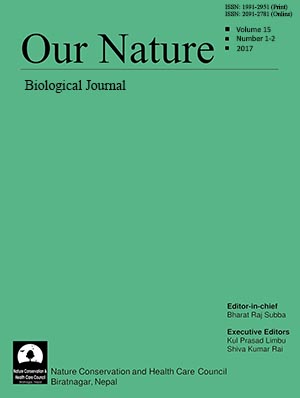On the Bayat (Turkey) rugs, motif stories, used dyeing plants and their ethnobotanical properties
DOI:
https://doi.org/10.3126/on.v15i1-2.18790Keywords:
Madder, Wool Carpet, Design, Anecdote, Staining plants, MAPsAbstract
Bayat rugs weaved with different madders can be used without fading their colors almost 100 years. The study aimed to record how to get madder by traditional methods from local plants, give stories of rug motives and present an overview of the medicinal uses of dyes plants collected in Afyonkarahisar, Inner-West Anatolia, Turkey. The study was conducted in both 11 villages and downtown of Bayat borough of Afyonkarahisar in 2013-2014. A total 150 women, aged between 17-25, were interviewed and observations were photographed. The rugs are completely 100% sheep wool and strings for weaving prepared traditionally by special spinning methods. The used plants to obtain the madders were determined. It was understood that in early August and September, plants give better colors and tones. These plants have also been used for medicinal purposes by the locals. Bayat people get non-fading colors from 11 plants (Allium cepa L., Berberis crataegina L., Papaver rhoeas, Papaver somniferum L., Malva silvestris L., Morus nigra L., Cistus laurifolius L., Quercus ithaburensis Decne. subsp. macrolepis (Kotschy) Hedge et Yalt, Rubia tinctorum L., Juglans regia L., Indigofera tinctoria L.) belonged to ten families. The plant organs used are root, shell, cupula, leaf, young shoot, and aerial parts of the plants. A natural mud is also used as alum in this region that provides to create dark colors, and prevents mixing the colors. It also inhibits fading the colors in the rugs’ texture. It was also recorded that different motives in Bayat Rugs have also interesting historical stories.Downloads
Download data is not yet available.
Abstract
986
PDF
1055
Downloads
Published
2017-12-25
How to Cite
Arı, S., Kargıoğlu, M., & Konuk, M. (2017). On the Bayat (Turkey) rugs, motif stories, used dyeing plants and their ethnobotanical properties. Our Nature, 15(1-2), 19–25. https://doi.org/10.3126/on.v15i1-2.18790
Issue
Section
Articles
License
This license enables reusers to distribute, remix, adapt, and build upon the material in any medium or format for noncommercial purposes only, and only so long as attribution is given to the creator.




